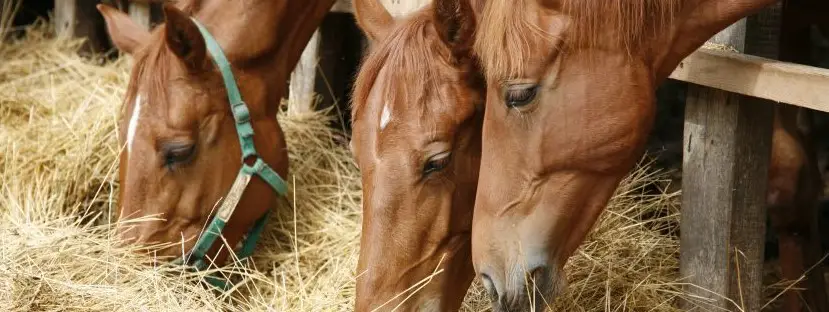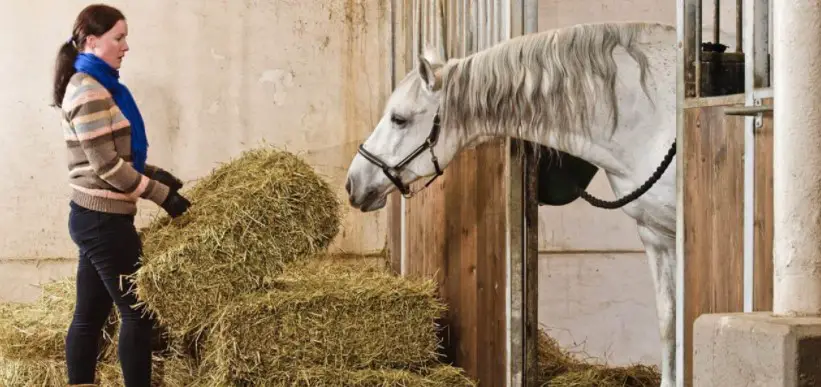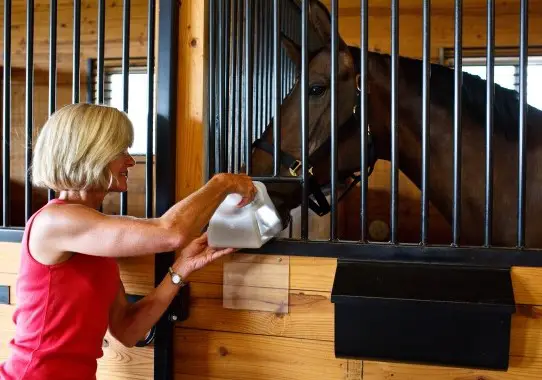Right from the initial moment you walked up to a horse, it is highly likely that you heard the rules of engagement. Don’t run away, never walk behind a horse, feed them treats with outstretched palms, are just some of the guidelines attached. However, the most important rules for grooming a healthy stallion or mare are attached to feeding habits.
Grass and hay are two of the most popular foods for horses. When horses eat grass, you must monitor their condition to ensure that they are not consuming too much or too little. Sadly, this is because overeating can also cause a horse to become obese. Lack of hay might also cause a horse’s weight loss. So, how much hay does a horse eat? First off, let’s answer a few background questions, if you will.
Why Should Horses Eat Hay?
Horses are conditioned to eat roughage. Their digestive systems are built to use the nourishment found in stalks of grass. A horse should consume roughage that amounts to a percent or two of their total body weight every day. There is no better source of roughage for horses than hay.

Many trail horses do not require grain; instead, they thrive on high-quality hay or pasture. If hay isn’t enough, grain can be given, but roughage should always provide most of a horse’s calories.
On the other hand, horses that spend most of their time in stalls and do not graze so frequently can recreate their natural feeding patterns. This can be achieved by having hay in front of them for most of the day. They can nibble on it for a while, take a breather and rest for a bit, and then return to it, ensuring that roughage is constantly going through their bodies.
Rules For Feeding Your Horse Hay
There are specific rules that one must obey when feeding a horse hay.

- Small, frequent meals are more natural for horses, and they also improve how your horse digests and absorbs food. A horse fed too much food at once does not digest it well.
- Every horse has a unique set of requirements. When determining how much food they require, consider both their physical size and the work they perform.
- Think about how much pasture or hay your horse receives. Horses who cannot get enough turnout or aren’t on decent pasture, whether indoors or out, will need extra hay.
- Depending on available pasture, you can reduce or altogether remove hay rations when the grass is rich and green.
- If the level of work your horse performs changes, then make consequential adjustments to their food ration.
- Avoid feeding your horse immediately before or after exercise. Ideally, it would be best if you wait an hour or so after your horse has finished a meal before riding him. If you’re going to do something physically demanding, you should plan on spending closer to three hours.
How to Change Feed and Feed Schedules
It would help if you made carefully planned, incremental adjustments whenever you have to alter your horse’s ration size or feed type. If you’re changing the feed quantity, make minor adjustments to each meal at a time, gradually increasing or decreasing the serving over several weeks. A popular way of altering the feed type is by replacing 25% of the existing food type with its substitute daily. By doing so, you ensure that the horse eventually eats 100 percent of the new food after six days of feeding.

How To Accurately Measure Feed?
Begin by weighing your horse‘s feed on a postal or kitchen scale or at your local feed store. As long as you know how much your horse‘s normal ration weighs, you can measure it with a scoop, a coffee can, or any other item of your choosing.
How Much Hay Does a Horse Eat?
Horses that rely on hay as their sole source of nutrition eat between fifteen and twenty pounds of hay daily. Flakes are the most common method of dispensing hay; however, a flake’s hay content can vary substantially depending on the flake’s size and type of hay.
Use a bathroom scale to weigh the bales of hay you’re feeding your horse, and then only provide it the fraction of the bale that it actually requires. It should be around 60 pounds or 23 kilograms. The bales will be too lengthy and densely packed if the hay is too wet.
You can now calculate the approximate number of flakes you should feed your horse daily. So, for a flake weighing four pounds, you’ll need to provide your 1000-pound horse with five flakes daily. Keep in mind to feed as many small portions as possible.
How Much Hay Do Ponies Eat?
Ponies have a slower metabolism than horses. That is why they require a lower percentage of their body weight in hay unless they are hard workers—a rarity in today’s ponies. Small ponies may only need a couple of flakes per day to stay healthy.
However, some draft horses, particularly those that work hard, will require far more hay than the standard ratio. Therefore, it is critical to regularly monitor your horse’s condition and make adjustments based on the weather, how hard the horses are working, their age, the hay’s richness, and their general health.
Always Stick to a Routine
Horses thrive on routine, possessing incredibly accurate internal clocks that help them keep better time than their human caregivers. Therefore, follow a consistent schedule when feeding horses.
Abrupt schedule changes are harmless to most horses. However, horses prone to colic find sudden alterations in routine more than an annoyance but a trigger for a colic episode.
Conclusion
Hay is a necessary food item for horses. Your horse will get their daily fiber intake from this and have a fulfilling meal. However, it would be best if you kept an eye on how much hay you’re feeding your horse. If you give them their daily hay in a proper and adequate measurement, your horse will be safe from over intaking of fiber and other related health issues.
We recommend you keep a record of all the meals your horse takes and make weekly adjustments accordingly.
